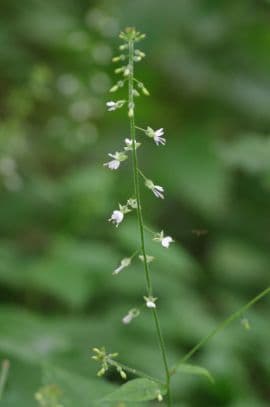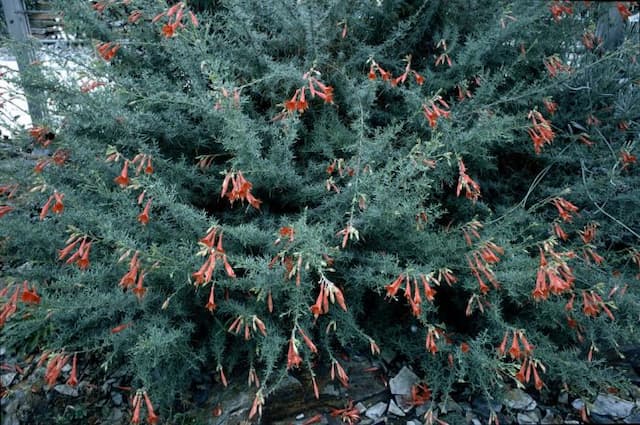Fuchsia Fuchsia 'Mercurius'

ABOUT
Fuchsia 'Mercurius' is a captivating ornamental plant favored for its beautiful hanging flowers. The flowers are quite distinctive and memorable, with a graceful droopiness that adds a touch of elegance to any space. These blooms have a dual color palette, often showcasing a deep purple to almost black corolla - which is the inner set of petals, and contrasting vividly with the red sepals - the outer leaves that are typically green in other plants but are brightly colored in fuchsias. The overall form of the flower resembles a dainty, inverted bell. Adding to the charm, the long, slender stamens extend from the flower, curving gracefully below, often peeking out beyond the petals. The leaves of Fuchsia 'Mercurius' provide a lush backdrop to its dramatic flowers. They are oval-shaped with a slight point at the tip, and the edges can be softly serrated, giving them a somewhat delicate, yet full appearance. The foliage tends to be a rich green, which nicely complements the intense colors of the blooms. The growth habit of Fuchsia 'Mercurius' can be somewhat bushy, with the branches gently arching under the weight of the flowers. This characteristic makes it an excellent choice for hanging baskets or as a feature in a mixed border where its pendulous flowers can hang and be admired. Overall, Fuchsia 'Mercurius' is renowned for its vibrant blooms that dangle like ornate earrings from the branches, creating a striking visual impression that makes it a highly sought-after variety for gardeners and floral enthusiasts.
About this plant
 Names
NamesFamily
Onagraceae.
Synonyms
Lady's Eardrops, Fairy Bells, Hummingbird Fuchsia, Swingtime Fuchsia.
Common names
Fuchsia 'Mercurius'.
 Toxicity
ToxicityTo humans
Fuchsias, including the 'Mercurius' variety, are generally considered non-toxic to humans. There are no well-documented cases of poisoning from consuming parts of the fuchsia plant. However, as with any plant, individual sensitivities and allergic reactions could occur. If symptoms are observed after ingesting fuchsia plant material, it is advisable to seek medical advice.
To pets
Fuchsias, including the 'Mercurius' variety, are typically not toxic to pets such as dogs and cats. They are generally regarded as safe and there are no widespread reports of poisoning in pets from fuchsia consumption. Nonetheless, ingestion of plant material can sometimes lead to mild gastrointestinal upset in some animals, so it's recommended to keep an eye on your pet and contact a veterinarian if any unusual symptoms develop after ingestion.
 Characteristics
CharacteristicsLife cycle
Perennials
Foliage type
Deciduous
Color of leaves
Green
Flower color
Mixed
Height
2 feet 6 inches (0.76 meters)
Spread
2 feet 6 inches (0.76 meters)
Plant type
Shrub
Hardiness zones
9
Native area
Central and South America
Benefits
 General Benefits
General Benefits- Ornamental Appeal: Fuchsia 'Mercurius' is known for its attractive and colorful pendant flowers, which can enhance the visual appeal of any garden or landscape.
- Pollinator Attraction: The flowers of this plant attract hummingbirds, butterflies, and other pollinators that are beneficial for the ecosystem.
- Container Gardening: It is well-suited for container gardening, allowing those with limited space to grow the plant on balconies, patios, or indoors.
- Shade Tolerance: This variety of fuchsia performs well in partial shade, making it a great option for areas of the garden that receive less sunlight.
- Long Blooming Period: Fuchsia 'Mercurius' has a lengthy flowering season, providing continuous color and interest throughout the growing months.
- Easy Propagation: The plant can be easily propagated from cuttings, allowing gardeners to create more plants without the need for seeds.
- Varied Landscaping Uses: It can be used in a variety of settings, including hanging baskets, beds, and borders, offering flexibility in garden design.
 Medical Properties
Medical PropertiesThis plant is not used for medical purposes.
 Air-purifying Qualities
Air-purifying QualitiesThis plant is not specifically known for air purifying qualities.
 Other Uses
Other Uses- Edible Flowers: The blooms of the fuchsia plant are edible and can be used in fresh salads to add a splash of color and a slightly tart flavor.
- Garnishes: Fuchsia flowers make attractive garnishes for desserts and cocktails, offering both ornamental and culinary value.
- Natural Dye: The petals of fuchsia flowers can be used to make a natural dye for fabric or paper crafting.
- Photography Subject: Fuchsia flowers are often photographed due to their unique shape and vibrant colors, making them a popular subject for botanical photographers.
- Teaching Tool: Fuchsia plants can be used in educational settings to teach botany and the process of pollination due to their interesting flower structure.
- Flower Arrangement: Fuchsia's drooping blooms add a dramatic touch to flower arrangements and bouquets.
- Jewelry Making: Dried fuchsia flowers can be incorporated into handmade jewelry, such as being set in resin for pendants or earrings.
- Art Inspiration: The intricate shapes and bright colors of fuchsias inspire artists, lending themselves to paintings, drawings, and textile designs.
- Cake Decoration: Fresh or candied fuchsia flowers can be used to adorn cakes and pastries for a touch of elegance.
- Bonsai Art: Some fuchsia varieties can be grown as bonsai, offering a unique challenge and beauty to connoisseurs of this Japanese art form.
Interesting Facts
 Feng Shui
Feng ShuiThe plant Fuchsia is not used in Feng Shui practice.
 Zodiac Sign Compitability
Zodiac Sign CompitabilityThe plant Fuchsia is not used in astrology practice.
 Plant Symbolism
Plant Symbolism- Grace and Elegance: Fuchsias, with their dangling, lantern-like flowers, are commonly associated with grace and elegance due to their delicate appearance and the way they move in the breeze.
- Good Taste: The vivid colors and unique shape of fuchsia flowers symbolize refined preference and good taste, often representing individuals who appreciate beauty and aesthetics.
- Confiding Love: In the language of flowers, fuchsias can represent confiding love, where someone is entrusting their feelings to another. It’s a way of offering your trust to someone with your emotions.
- Warning: The fuchsia is sometimes considered as carrying a warning, possibly due to its vivid colors which, in nature, can signal caution or a form of defense.
- Amiability: The welcoming, open shape of the flower can symbolize amiability and warmth in relationships, indicating a friendly, social nature.
 Water
WaterThe Fuchsia 'Mercurius', also known as hardy fuchsia, requires consistent moisture and should be watered when the top inch of soil feels dry. Water thoroughly until excess water drains out of the bottom of the pot, ensuring the roots are evenly moistened. This might equate to watering once or twice a week, depending on climate conditions and the environment inside your home. During the growing season in spring and summer, the hardy fuchsia may require more frequent watering, while in winter, its water needs decrease. Avoid letting the soil become completely dry or waterlogged. It's challenging to prescribe a fixed amount of water due to varying conditions, but start with approximately one-quarter to one-half gallon per week and adjust as needed.
 Light
LightHardy fuchsias flourish in partial shade to filtered sunlight, preferring a spot that's shielded from the hot afternoon sun. They benefit from bright morning light with protection from intense midday rays, which can scorch their delicate flowers and leaves. The ideal location would offer dappled sunlight throughout the day or a position that receives some direct sunlight followed by shade.
 Temperature
TemperatureHardy fuchsias thrive in temperatures between 60°F and 75°F, avoiding extremes that can stress the plant. They can survive minimum temperatures down to about 40°F, but should not be exposed to freezing conditions regularly. Maximum temperatures for hardy fuchsias peak around 80°F, beyond which you should provide shade and enhance air circulation to keep them cool.
 Pruning
PruningPrune hardy fuchsias in early spring to encourage bushier growth and more blooms. Remove dead or weak branches, and shape the plant to maintain its size and appearance. Pruning is typically done annually, but you can also pinch out the tips of stems during the growing season to promote branching.
 Cleaning
CleaningAs needed
 Soil
SoilFuchsia prefers a well-draining mix with a pH of about 6-7. A blend of peat moss, perlite, and loam works well to promote healthy growth.
 Repotting
RepottingFuchsias should be repotted every two to three years or when they become root-bound. Spring is the ideal time for repotting.
 Humidity & Misting
Humidity & MistingFuchsias thrive with high humidity levels, preferably between 60% and 70%. They benefit from regular misting to maintain these conditions.
 Suitable locations
Suitable locationsIndoor
Place Fuchsia in bright, indirect light and maintain high humidity.
Outdoor
Hang Fuchsia in partial shade; protect from intense afternoon sun.
Hardiness zone
9-11 USDA
 Life cycle
Life cycleFuchsia 'Mercurius', also known simply as Fuchsia, starts its life from seed, with germination depending on temperature, moisture, and light conditions. Once the seeds sprout, seedlings slowly develop into young plants with characteristic fleshy leaves. As it matures, the plant enters the vegetative stage where it grows stems and leaves more vigorously, and after this period, it begins to flower, producing the distinctive pendulous flowers that Fuchsias are famous for, usually in the warmer months. The flowers are pollinated by birds, insects, or by artificial means, leading to the production of fruits that contain seeds for the next generation. After the flowering and fruiting season, in regions with cold winters, Fuchsia 'Mercurius' may enter dormancy, shedding leaves and reducing growth to survive the colder season. The plant will resume growth in spring, completing its annual cycle, and may also be propagated through cuttings, which are often taken in late summer or fall to grow new plants for the following season.
 Propogation
PropogationPropogation time
Spring-Early Summer
Fuchsia 'Mercurius', commonly known as hardy fuchsia, is typically propagated through softwood cuttings, which is the most popular method due to its efficiency and high success rate. The ideal time to take cuttings is in the spring to early summer when the plant is actively growing. To propagate using softwood cuttings, a healthy stem tip about 2 to 4 inches long is snipped just below a leaf node. The lower leaves are removed, and the cut end may be dipped in rooting hormone to encourage root growth. Then, the cutting is placed in a well-draining potting mix, kept moist, and covered with a plastic bag or placed in a propagator to maintain high humidity. Roots typically develop within a few weeks, after which the new fuchsia plant can be gradually acclimatized to less humid conditions before planting out.








![Fuchsia [Electric Lights]](/_next/image?url=https%3A%2F%2Fplants-admin.emdemapps.com%2Fimages%2Fplants%2F%2Fimages%2F604b5ba9b6455.png&w=640&q=75)
